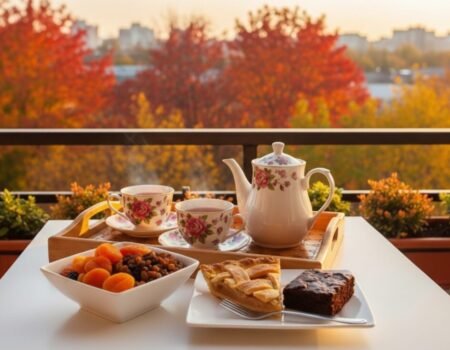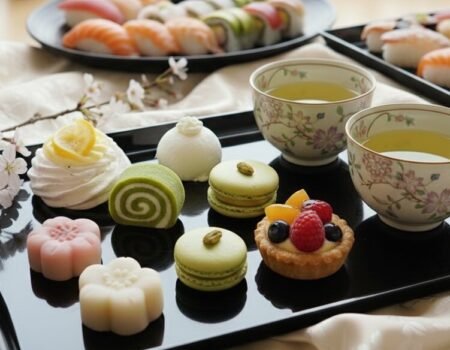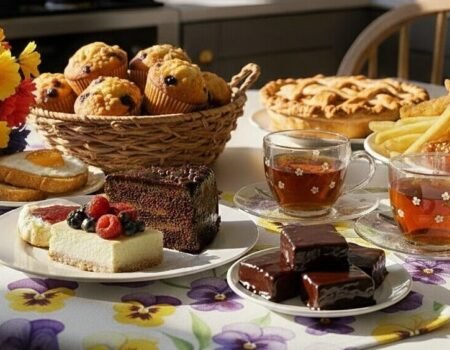
Delicious Pairing: Chocolate and Tea – Uniting Flavors for a Perfect Chocolate Tea Experience
Index
Both tea and chocolate have unique aromas and flavors that can reveal surprising harmony when paired well. The secret to a great pairing lies in understanding how these two treats interact on your palate.
This guide will walk you through the exact pairings that work, from dark chocolate with Earl Grey to white chocolate with matcha.
Key Takeaways
- Pairing tea and chocolate relies on matching intensity, cocoa percentage, and tannin levels to balance flavors without overpowering one another.
- Tea types like Earl Grey, Pu-erh, and dark oolong best complement high-cocoa dark chocolate (70% or higher), while white and herbal teas match with white chocolate.
- Studies recommend using single-origin chocolates from brands such as Mast Brothers and Valrhona for tastings since regional terroir affects flavor compatibility with specific loose-leaf teas.
- Premium pairing experiences or classes like Socola Chocolatier x Dartealing Lounge’s set or Raaka’s Floral Tea & Chocolate Pairing feature curated truffles or bars selected for optimal harmony.
- Experts stress the importance of palate cleansing between pairings using plain crackers or water to highlight subtle notes in each tea-chocolate combination during tastings.
What Are the Principles of Chocolate and Tea Pairing?
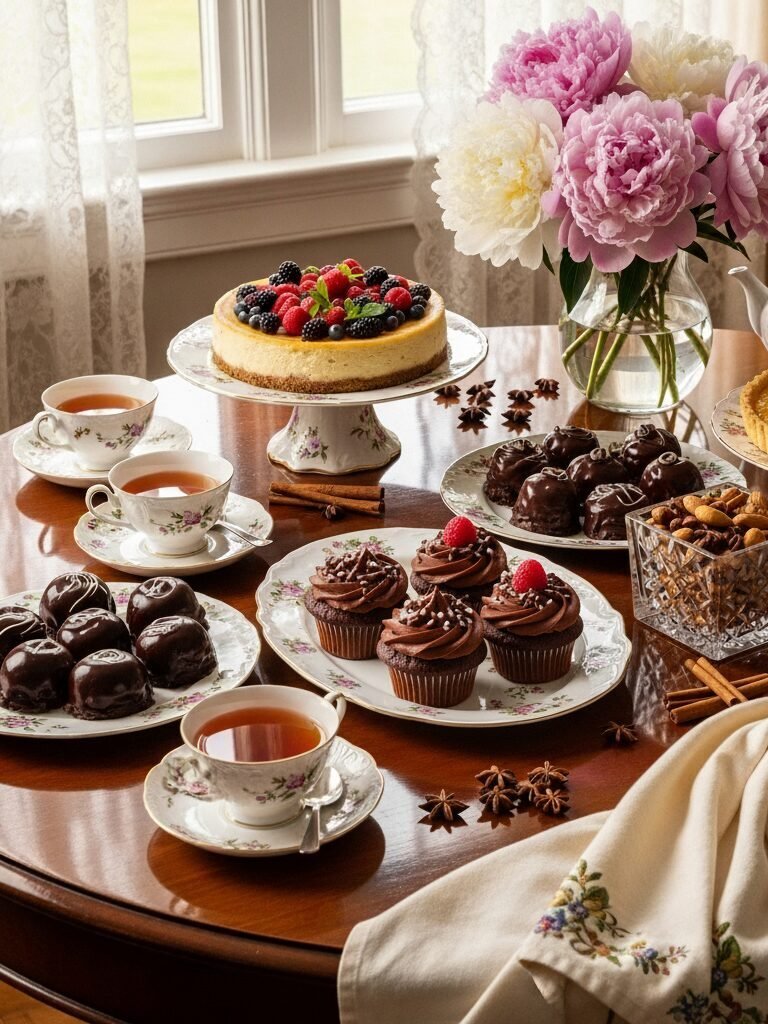
Understanding how flavors work together is the foundation of any great pairing. When you know the basic principles, you can create combinations that enhance both the tea and chocolate instead of having one overpower the other.
Matching Intensity Levels
Think of intensity like volume on a speaker. You want both the tea and chocolate to be heard clearly.
Delicate teas such as jasmine or silver needle white tea work best with light chocolates, like creamy white chocolate. Bold flavors in dark oolong or strong black tea stand up to the deep richness of dark chocolate bars. The secret lies in ensuring both the tea and chocolate have a similar strength. According to Certified Tea Master Alison Dillon from Cup Above Tea, pairing delicate white teas like Silver Needles with chocolate will cause the chocolate to overpower the tea’s exceptional subtleties.
For example, a zesty Chinese black tea brings out earthy notes from high-cocoa solids found in 70% dark chocolate. Milk chocolate proves versatile because its middle-ground sweetness pairs well with chai latte’s spices or milky oolong’s gentle aroma.
Choose hot black tea for chocolaty desserts to amplify that cocoa butter texture without washing away sweet vanilla notes. You should be able to taste both the tea and the chocolate; neither should steal the show.
Complement vs. Contrast Approach
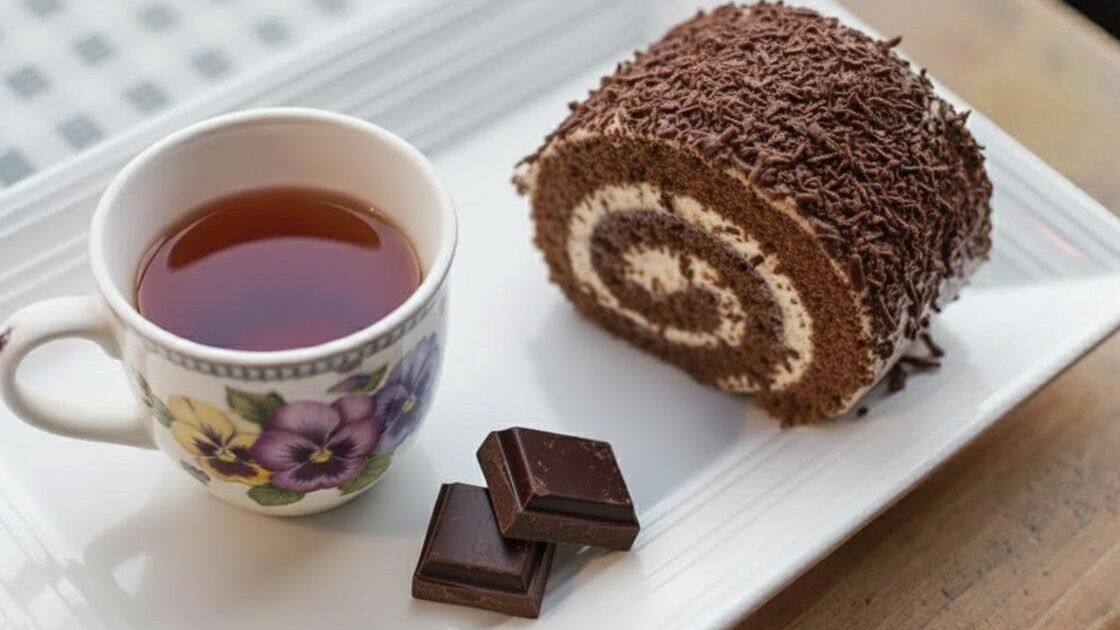
You have two main strategies when pairing: find similarities or embrace differences.
Complementing pairs use compatible flavor notes, combining teas and chocolates that share similar aromas or tastes. For instance, orange-infused chocolate matches perfectly with a honey-sweet oolong tea. This pairing boosts the citrusy aroma and creamy mouthfeel of both hot beverages while keeping their flavors in harmony.
Contrasting combinations rely on opposing profiles for balance and excitement in each bite or sip. When combined, spicy dark chocolate and smooth green tea offer a complex interplay—green tea’s freshness accentuates the spice, providing nuanced finish. Pu-erh blends well with bittersweet high-percentage cocoa because its earthy character stands out against bold chocolate flavors.
Using these techniques helps reveal surprising layers within both hot chocolate and your chosen brew.
Cocoa Percentage Considerations
The cocoa percentage on a chocolate bar tells you how intense the chocolate flavor will be.
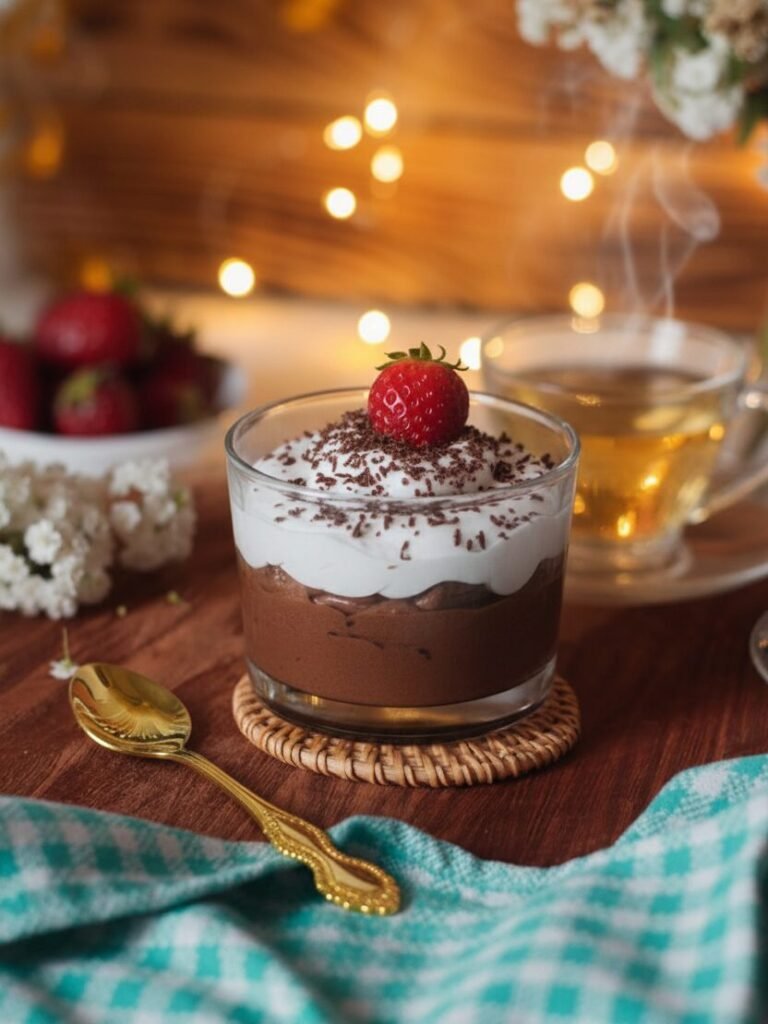
Chocolates with 30% to 70% cocoa content create the best flavor profile with most teas, compared to bitter 99% dark options that can overpower the pairing. Milk chocolate, which ranges from 10% to 55% cocoa, blends smoothly with lighter teas like green tea or white tea because of its creamy texture and gentle sweetness.
According to research from matcha chocolate market analysis, the global matcha chocolate market expanded rapidly in 2024 and is projected to grow substantially by 2032, indicating growing consumer interest in specific tea-chocolate pairings.
Higher cocoa percentages match well with earthy tea or strong black teas such as English breakfast, letting both flavors stand out without clashing. Lower cocoa chocolates pair better with delicate oolongs or herbal tea for balanced flavor combinations.
Understanding Tannin Interactions
Tannins are natural compounds that create that dry, slightly puckering sensation in your mouth.
Tannins, present in both tea leaves and cacao, shape the mouthfeel of any chocolate and tea pairing. Tannin-rich teas such as strong black teas or dark oolong can create astringency that sometimes exaggerates bitterness in high-cocoa chocolates. Choosing chocolate with a higher fat content helps smooth out this dryness since the cocoa butter binds to tannins and softens their effect.
Opposite profiles, like pairing a creamy milk tea with bittersweet dark chocolate, help avoid overpowering flavors from tannin-heavy options.
Palate cleansing between sips heightens subtle aromatic notes while controlling lingering tannic sensations on your tongue. Understanding how polyphenols interact improves every tasting session by enhancing harmony instead of creating clash.
What Tea Goes Best with Dark Chocolate?

Dark chocolate’s bold, bittersweet profile needs a tea that can match its intensity. The right pairing will highlight fruity undertones in the chocolate while the tea’s depth rounds out any harsh edges.
Let me show you the teas that work beautifully with dark chocolate.
Black Tea with Dark Chocolate
Earl Grey’s bold bergamot aroma cuts through the richness of high-cocoa dark chocolate, creating a flavor pairing that highlights both the tea and the chocolate. According to research on Earl Grey and dark chocolate pairings, the bergamot’s citrus notes act as a “flavor cleaner” that cuts through chocolate’s fat and prevents cloying sweetness while the tea’s astringency provides balance.
The citrusy notes in Earl Grey match well with fruity undertones commonly found in single origin bars from Ecuador or other cocoa-rich regions. Darjeeling black tea brings a light grape-like acidity which works beautifully with chocolatey desserts featuring sea salt or cocoa nibs.
English Breakfast, Grand Yunnan Imperial, and other strong teas offer deep flavors that balance intense levels of cocoa powder. High-quality loose-leaf versions give clean layers of malt, honeyed sweetness, or even smoky hints depending on the style. Keep your black tea pure without milk or sugar to showcase its complexity; this approach prevents overpowering delicate aromas like those found in fine dark chocolate.
Between bites, sip black tea to cleanse your palate so each taste pops anew while tannins interact gently with rich textures.
Pu-erh with Dark Chocolate
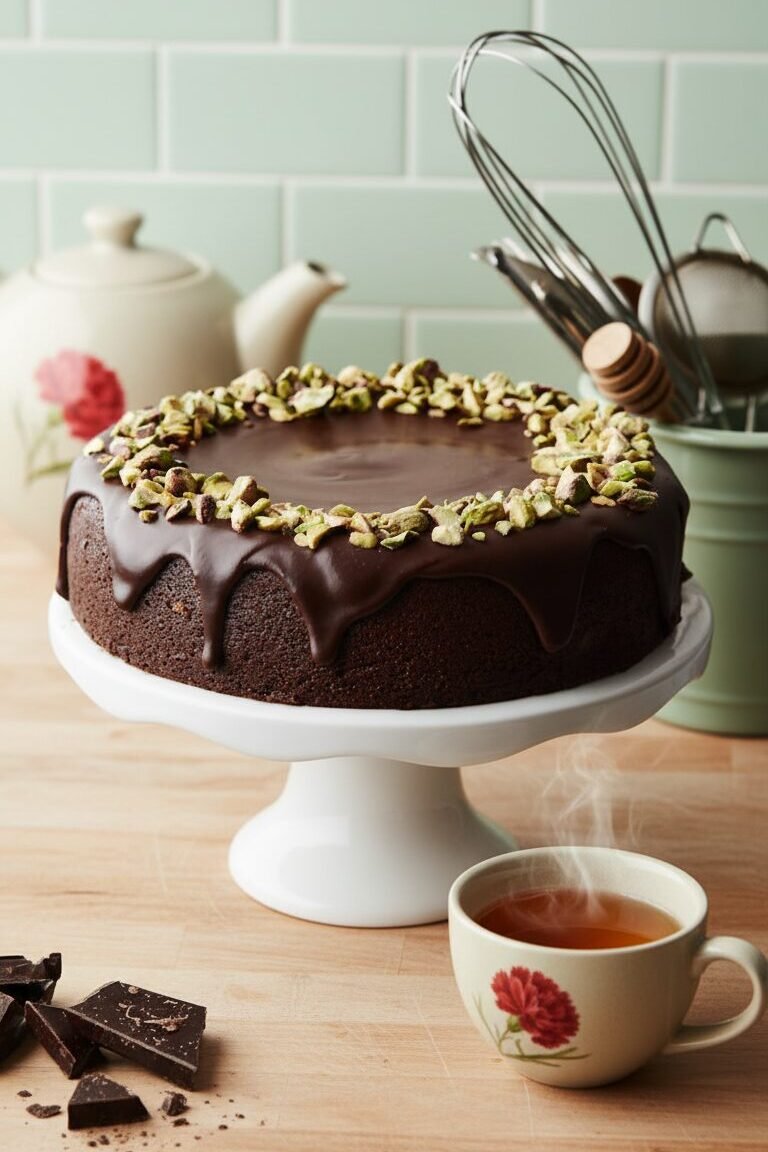
Pu-erh tea, known for its earthy flavor and aged character, pairs beautifully with dark chocolate that contains at least 70 percent cocoa.
The bitterness of high-cocoa dark chocolate brings out the deep aroma of Pu-erh while highlighting subtle notes reminiscent of forest soil and aged wood. This pairing offers a rich experience without overpowering flavors. Both Pu-erh tea and dark chocolate provide antioxidants which boost cardiovascular health when enjoyed together.
Sip Pu-erh to cleanse your palate after each bite; it also promotes digestion, making every taste of creamy, intense chocolate smoother.
Experiment with different origins or single-estate chocolates to discover new dimensions in both the tea and the chocolate flavored treat.
Dark Oolong with Dark Chocolate
Transitioning from the earthy, aged profile of pu-erh, dark oolong brings a different richness to dark chocolate pairing.
Dark-leafed oolong teas show deep mineral tones that boost the roasted cocoa notes in high-percentage chocolates. These teas go through more oxidation than lighter oolongs, which gives them enough strength to match the intense flavors found in 70% or even 85% cacao bars.
High-quality loose-leaf dark oolong can reveal hidden fruity layers in dark chocolate while its roasted finish leaves a warming sensation on your palate. Both tea and chocolate contain antioxidants and offer complex aromas like toasted nuts or dried fruit. Avoid adding any milk or sugar to your cup so you do not muffle these delicate flavors.
In my research into tea pairings, this combination creates some of the most satisfying finishes during a tea and chocolate tasting session.
What Tea Pairs with Milk Chocolate?
Milk chocolate’s smooth texture and creamy sweetness open up many exciting tea and chocolate pairing choices. Its moderate cocoa content makes it the most versatile chocolate for pairing.
Here are the teas that bring out the best in milk chocolate.
Green Tea with Milk Chocolate
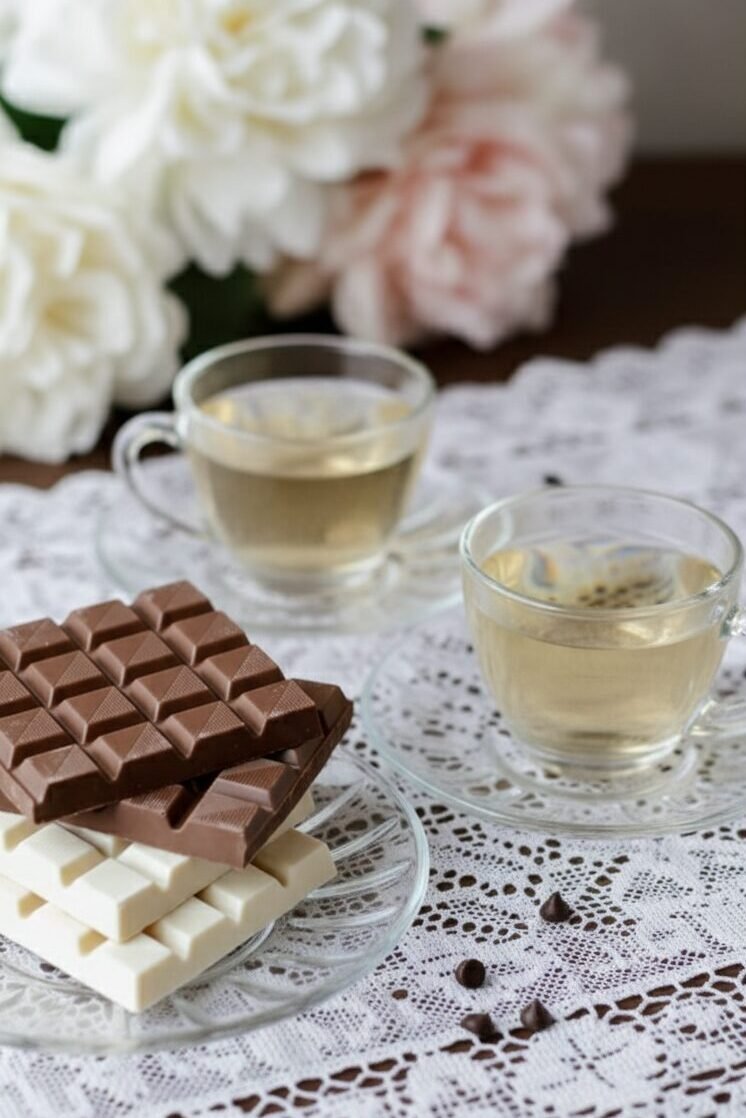
Jasmine Green Tea pairs beautifully with milk chocolate. The floral notes in this tea gently highlight the sweet, creamy flavor of milk chocolate without overwhelming it.
Sencha brings grassy freshness that balances the creaminess many crave in a classic pairing. Dragonwell offers a nutty undertone while Genmaicha, made with roasted rice, adds toasted warmth to smooth cocoa treats.
Matcha stands out because its concentrated flavor and theobromine content create an energizing duo with milk chocolate’s sweetness. According to industry data from 2024, matcha chocolate products have grown 21% year-over-year across major Western retailers, with individually wrapped matcha truffles and matcha white chocolate-covered nuts leading the trend. Gyokuro is prized for its natural sweetness; it matches well thanks to both teas’ lighter intensity and delicate taste profile.
Darker chocolates can hide green tea’s subtle flavors, so stick to lighter types for balance in every bite and sip.
White Tea with Milk Chocolate
Pair white tea with milk chocolate to enjoy a light and refreshing tasting experience.
White tea’s gentle floral notes highlight the smooth, creamy texture of milk chocolate. Stronger chocolates can overpower delicate white tea, so this pairing works best for those who prefer milder flavors. Keep the white tea pure and free of additives during tastings to allow subtle aromas to shine through.
Those hosting a tasting can experiment with different types of milk chocolate alongside white teas like Silver Needle or Bai Mu Dan for variety.

Enjoying small bites of mild milk chocolate after sips from your French press brings out nuanced notes in both treats. This combination is ideal for guests seeking lighter pairings rather than strong stimulants like black tea or high-percentage cocoa bars.
Light Oolong with Milk Chocolate
Milky Oolong, such as Jin Xuan, pairs beautifully with milk chocolate due to its creamy taste and gentle aroma.
Lightly oxidized oolongs often remind people of green tea rather than black tea, offering delicate floral notes that highlight the smooth sweetness in milk chocolate. The texture of light oolong balances the richness of cocoa while keeping flavors harmonious instead of overpowering.
The natural milky flavor in Jin Xuan Oolong creates a seamless match with soft milk chocolate. Steamed-in-milk varieties enhance both creaminess and subtlety during each sip.
Trying different light oolongs, like Taiwanese Ali Shan or Tie Guan Yin from China, can reveal interesting combinations for those who enjoy pairing fine tea and sweet treats.
What Tea Complements White Chocolate?
White chocolate’s creamy sweetness invites tea with gentle floral or herbal notes. Because white chocolate contains no cocoa solids, only cocoa butter, it needs a tea that can provide contrast or complement its rich, vanilla-forward profile.
Let me show you which teas work best.
Herbal Tea with White Chocolate
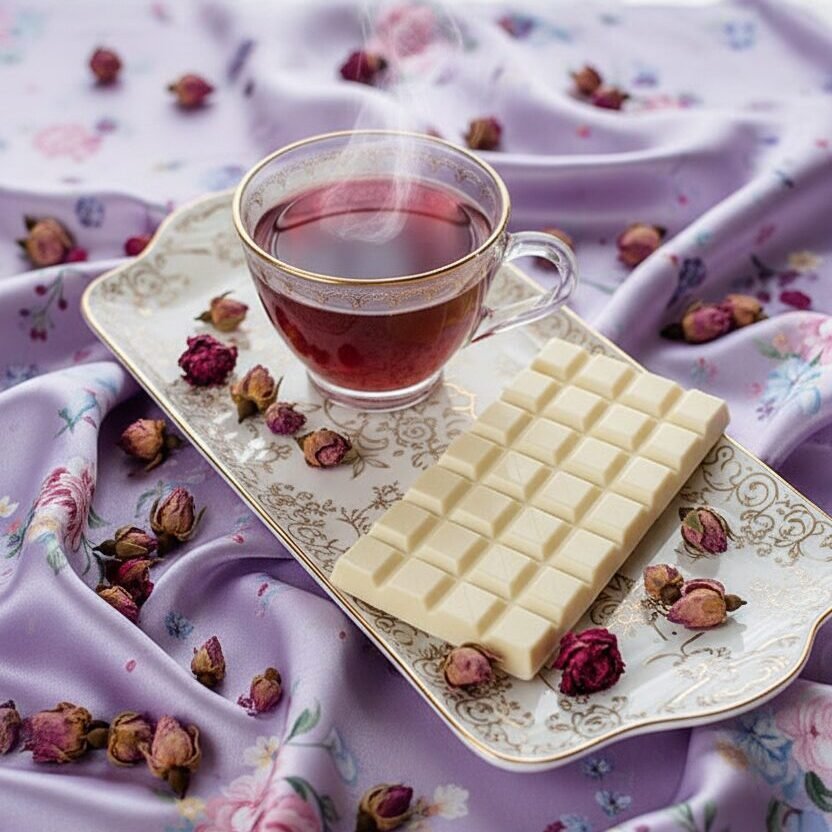
Chamomile and hibiscus teas create gentle harmony with white chocolate.
Chamomile tisane softens the creamy sweetness of cocoa butter, while tart hibiscus infuses a slight tang. Spiced chocolates find balance when served with herbal infusions, giving warmth to each bite without overshadowing delicate notes. Fruity blends uplift subtle vanilla tones, enhancing both aroma and flavor.
Rely on texture and aroma during tastings to lift the experience beyond taste alone. Engage your senses as you hold the cup near your nose; inhale floral or citrus odors before sipping water for palate cleansing between pairings.
Experimenting with smoky oolong or tart hibiscus alongside chocolate offers depth not found in standard combinations.
White Tea with White Chocolate
White tea and white chocolate create a gentle pairing that highlights sweet, floral flavors.
White chocolate’s creamy texture softens the delicate profile of white tea without overwhelming it. Together, they build a subtle taste experience that suits those who prefer light desserts or spring-inspired tastings. This combination often draws out hidden blossom-like notes in both the tea and chocolate.
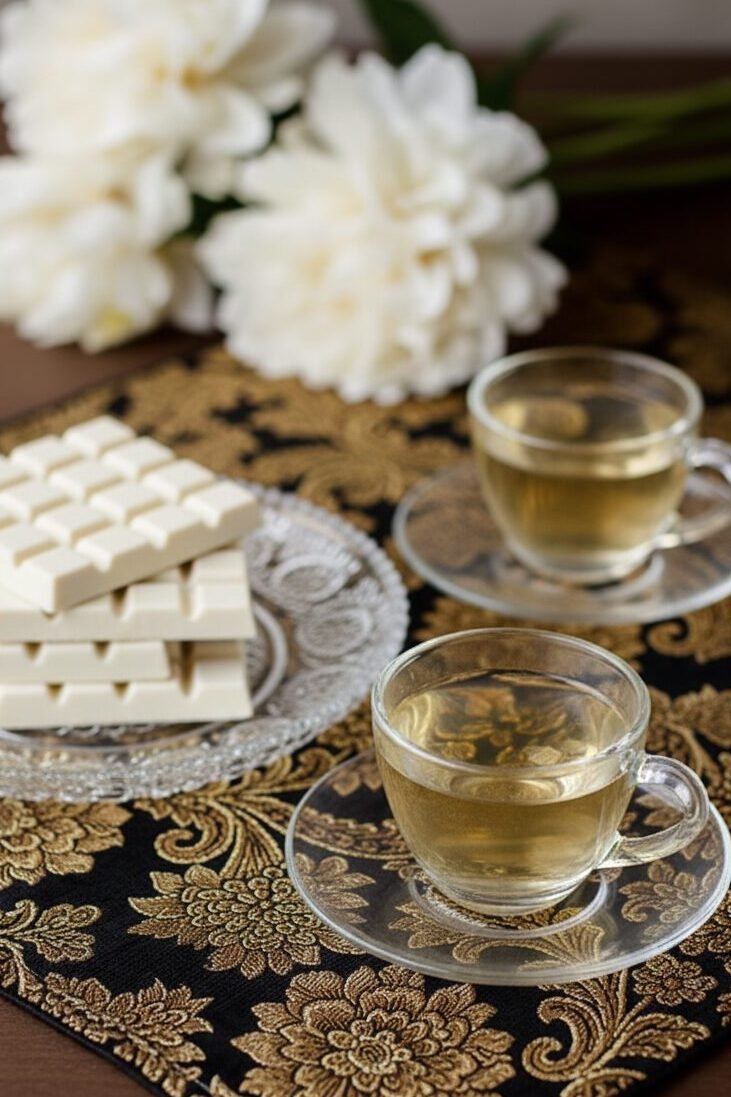
Serving this pair works well for elegant dessert courses or afternoon gatherings.
The mild cocoa taste of white chocolate complements rather than competes with white tea’s softness. Guests may notice how the natural sweetness in each element brings harmony to the palate while avoiding heavy or bold contrasts seen in other matches.
Delicate Green Tea with White Chocolate
Pairing delicate green tea with white chocolate creates a balanced experience.
Green tea’s gentle grassy notes contrast the creamy sweetness of white chocolate, letting both flavors shine. Matcha, widely used in Japanese and Western desserts, offers a bright color and earthy depth when combined with smooth white chocolate. According to Certified Tea Master Alison Dillon, matcha is one of the most bitter-tasting green teas, and this extreme bitter profile directly contrasts white chocolate’s sweetness, creating what she describes as a “really luxurious mouthfeel.”
Fruit-based herbal teas or floral greens like jasmine also highlight subtle cocoa butter tones in the chocolate.
Hosting a tasting party? Try different types of green teas such as Chinese Longjing or Japanese Sencha alongside small pieces of premium white chocolate. Many dessert makers blend these elements for their refreshing bite and elegant finish, making this duo popular across Asia and Europe alike.
How to Pair Tea with Chocolate Desserts

Chocolate desserts offer a perfect opportunity to explore tea pairings beyond simple chocolate bars. The texture, added ingredients, and preparation methods of desserts change how tea interacts with chocolate.
Here’s how to match your favorite teas with popular chocolate treats.
Tea with Chocolate Cake
Chocolate cake and tea create a memorable combination.
You can pair rich chocolate cakes with full-bodied black teas such as Assam or Keemun for a balanced taste. Their malty notes highlight the deep cocoa flavors while controlling sweetness and bitterness. Dark oolongs also work well, adding roasted nut hints to each bite.
If you want more contrast, try an aromatic Earl Grey; its citrusy aroma brightens dense layers of chocolate.
Sides like fresh fruit slices, cheese boards, or toasted nuts can add new textures and flavors to your tasting table. Including mini sandwiches or scones encourages guests to slow down between bites of cake and sips of tea. For special occasions, consider using high-quality ingredients in both the cake and the tea so each flavor stands out clearly.
Tea with Chocolate Truffles
Socola Chocolatier and Dartealing Lounge feature a Chocolate and Tea Pairing Set with 12 artisan truffles.
Four truffles are selected specifically for tea pairing while the other eight offer a chance to explore unique flavors separately. Each box comes with gourmet tea from Dartealing Lounge, instructions, and detailed tasting notes. Both Socola Chocolatier and Dartealing Lounge are women-owned companies known for crafting premium chocolate and quality teas.
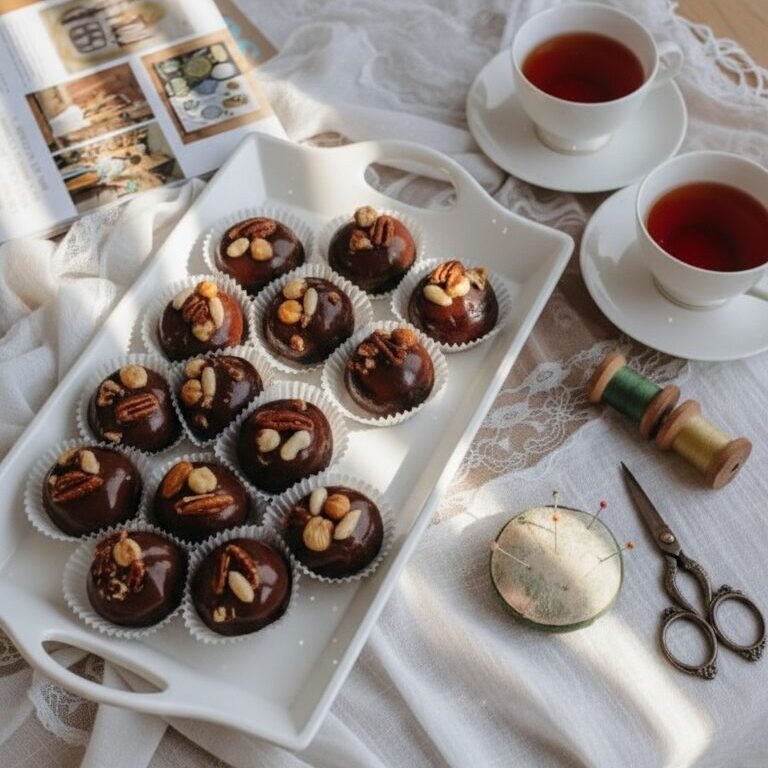
To prepare your own session at home, gather the pairing set along with four heat-proof cups, hot water, and a teaspoon.
Truffle ingredients may include dark or white chocolate blends using cacao beans, pure cane sugar, cocoa butter, sunflower lecithin, vanilla beans, full milk powder or wheat; they may contain allergens such as milk or soy. Sip the paired tea before biting into each truffle to notice how flavors shift on your palate, sometimes complementing rich chocolate notes or brightening them with floral or earthy undertones.
Tea with Brownies and Cookies
Pairing tea with brownies and cookies creates new ways to enjoy chocolate desserts.
Rich black teas, like Assam or English Breakfast, highlight the fudgy depth of brownies. Peppermint tea brings a refreshing coolness when paired with room temperature or slightly warmed chocolate chip cookies. This pairing approach helps reveal delicate notes in both the dessert and drink while engaging taste and smell.
Green teas pair nicely with lighter cookies, such as shortbread or sugar varieties. A brisk Darjeeling contrasts well with nutty blondies for added dimension.
Experimentation is key; tasting several pairings during a party can help you find your favorite combinations. Guests can cleanse their palates between bites to appreciate each unique flavor experience fully.

Tea with Chocolate Mousse
Chocolate mousse brings a silky, rich texture that welcomes tea pairings, especially with lighter teas.
Fruity teas like Raspberry Nectar can brighten each spoonful and balance the sweetness of the mousse. Floral teas such as jasmine green or rose-scented white tea lift the creamy chocolate notes and add a delicate aroma to every bite.
Serve warm tea next to room temperature or lightly warmed chocolate mousse for optimal taste. This pairing allows the flavors to mingle while keeping textures distinct.
Palate cleansing between tastings using plain crackers or sips of water lets you appreciate each flavor difference even more. Experimenting with several teas at one tasting, such as berry blends with dark cocoa mousse or jasmine green with milk chocolate mousse, often reveals remarkable new layers in your dessert experience.
What Are the Best Chocolate and Tea Pairings by Flavor?
Looking at flavor families helps you discover unexpected pairings. Instead of just matching chocolate types with tea types, you can explore how specific flavor notes work together.
Here are the best combinations organized by flavor profile.
Fruity Tea with Chocolate
Raspberry Nectar tea highlights the tart notes in berry chocolate truffles, letting both flavors shine in every bite.
Wild Berry Hibiscus tea stands out as a featured option for pairing, making it easy to match with raspberry or strawberry-infused chocolates. Fruity teas such as these bring out hidden berry or citrus notes in dark and milk chocolate while creating a lively spring and summer treat.
Hosting a tasting event using fruity teas gives guests an exciting way to explore new combinations, especially when contrasting rose tea with salted dark chocolate.
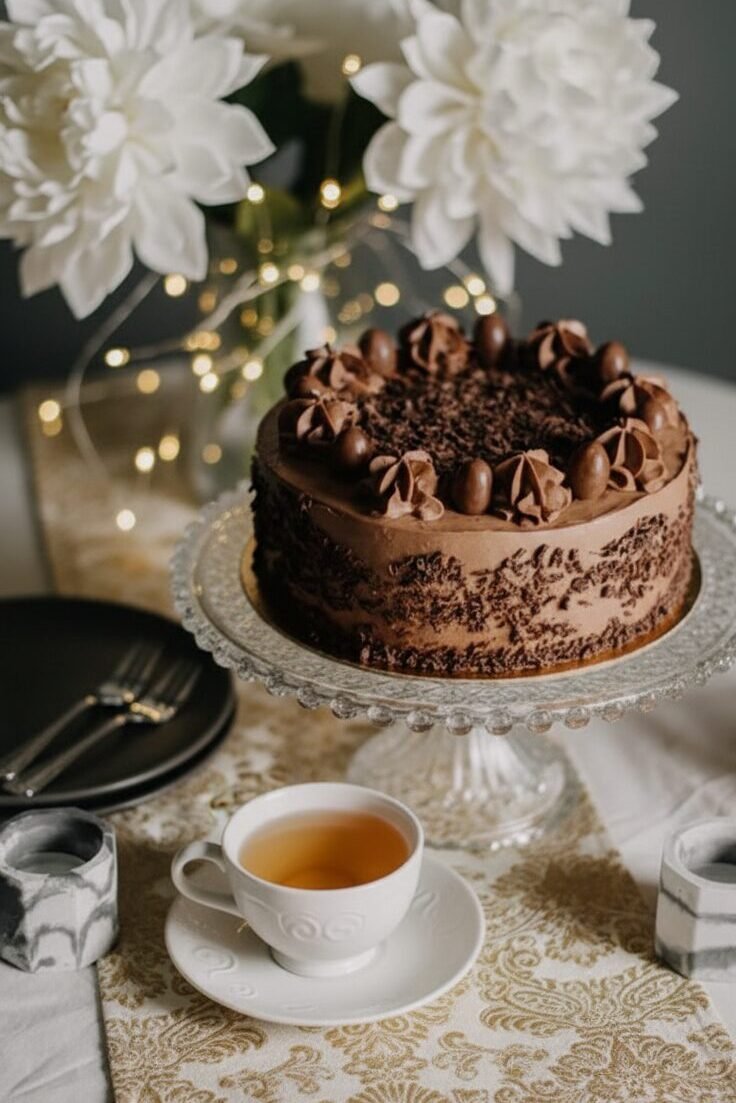
Floral Tea with Chocolate
Spring-inspired pairings of floral tea and chocolate create a refined tasting experience.
Raaka’s Floral Tea and Chocolate Pairing Class, brings this to life with curated selections for participants aged 8 and up. Their tastings feature handpicked floral teas like jasmine or rose alongside single-origin dark chocolates from their dairy-free factory in Red Hook, Brooklyn.
Floral notes in tea highlight subtle flavors in dark chocolate, enhancing both aroma and texture. The class includes lessons on identifying flavor profiles, brewing methods, and how each pairing complements the next.
Guests praise not only the delicious combinations but also the detailed instruction that deepens their appreciation for nuanced tastes.
Earthy Tea with Chocolate
After exploring the delicate notes of floral teas paired with chocolate, we move to fuller and deeper flavor profiles.
Earthy teas, such as Pu-erh or aged Yunnan black tea, create a grounding match for rich dark chocolate. These teas bring out subtle cocoa nuances in high-cacao bars and add warming depth that feels comforting on crisp fall or winter days. Soil, region, and climate shape both tea leaves and cacao beans; quality loose-leaf tea made without milk or sugar will best preserve these natural flavors.
Serving earthy teas with chocolate intensifies the sensory experience. Dark Oolong also stands up well next to 70% cacao dark chocolate thanks to its slightly woody body and complex aftertaste.
Hosting a tasting session using earthy tea with fine single-origin dark chocolates highlights their shared terroir stories while revealing layered aromas like mushroom, forest floor, dried fruit, leather, or even tobacco leaf.
Spiced Tea with Chocolate
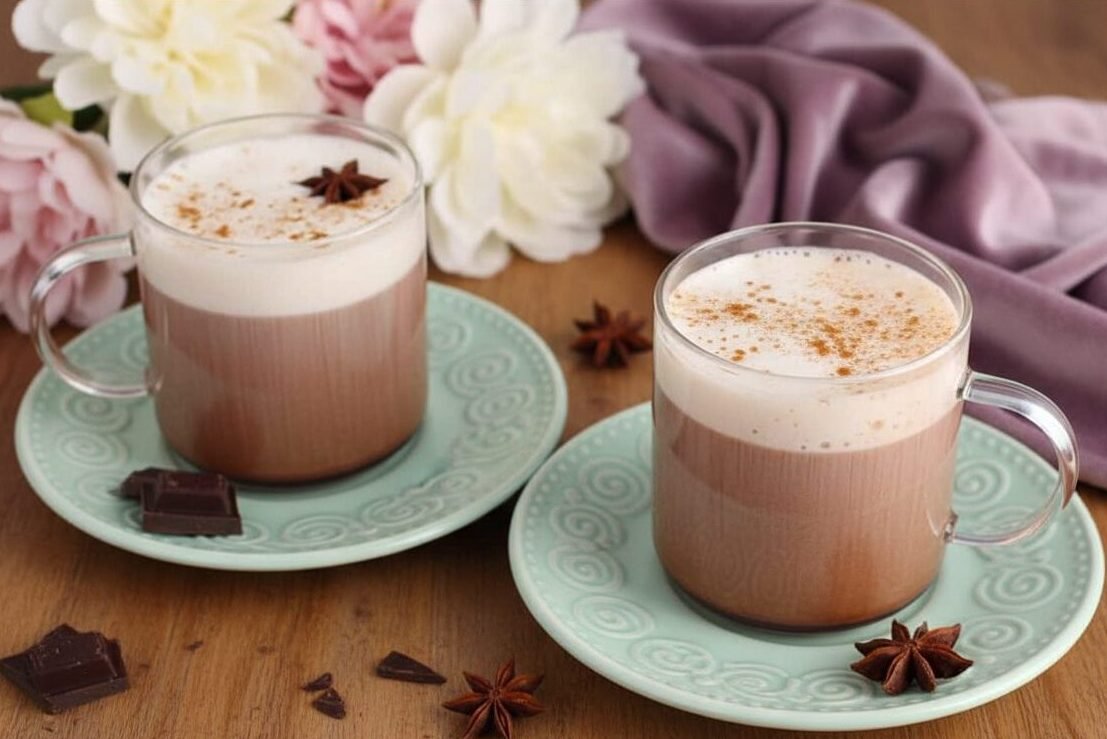
Spiced tea boosts the pleasure of chocolate, especially during cool months.
Chai tea or blends featuring cardamom and cinnamon match well with milk chocolate for a smooth and cozy pairing. Cinnamon or vanilla herbal teas also fit nicely, bringing out creamy notes in sweeter chocolates. Nutmeg or cinnamon-infused chocolates become richer when you sip spiced tea alongside them.
Chocolate chai tea offers an easy way to blend these flavors at home. Brew chai with pure cocoa nibs in boiling water to create a warming cup.
Stores now offer pre-blended chocolate chai teas if you want convenience without sacrificing flavor. Host a tasting by serving multiple spiced teas with different styles of chocolate as a fun group activity or thoughtful gift for friends who love unique experiences.
Smoky Tea with Chocolate
Shifting from spiced tea pairings, smoky teas introduce another layer of excitement to chocolate.

Smoky teas, such as Lapsang Souchong or roasted oolong, match well with dark chocolate because their bold flavors stand up to high cocoa percentages. These teas often come from black or oolong varieties that develop roasted aromas during processing.
Many people find the combination of smoky tea and chocolate adventurous and rewarding. A piece of 70 percent dark chocolate paired with a cup of smoky black tea creates a lingering, complex finish on your palate. This pairing suits evening tastings or gatherings where you want something different and memorable.
Experimentation can reveal surprising matches and highlight how smoke amplifies both sweetness and depth in chocolate desserts.
How Does Origin Affect Chocolate and Tea Pairing?
Where your tea and chocolate come from shapes their flavor in ways you might not expect. The soil, climate, and growing conditions create unique taste profiles.
Understanding origin helps you create pairings with natural harmony.
Single-Origin Chocolate Considerations
Single-origin chocolate highlights the unique flavors of cocoa beans grown in one place.
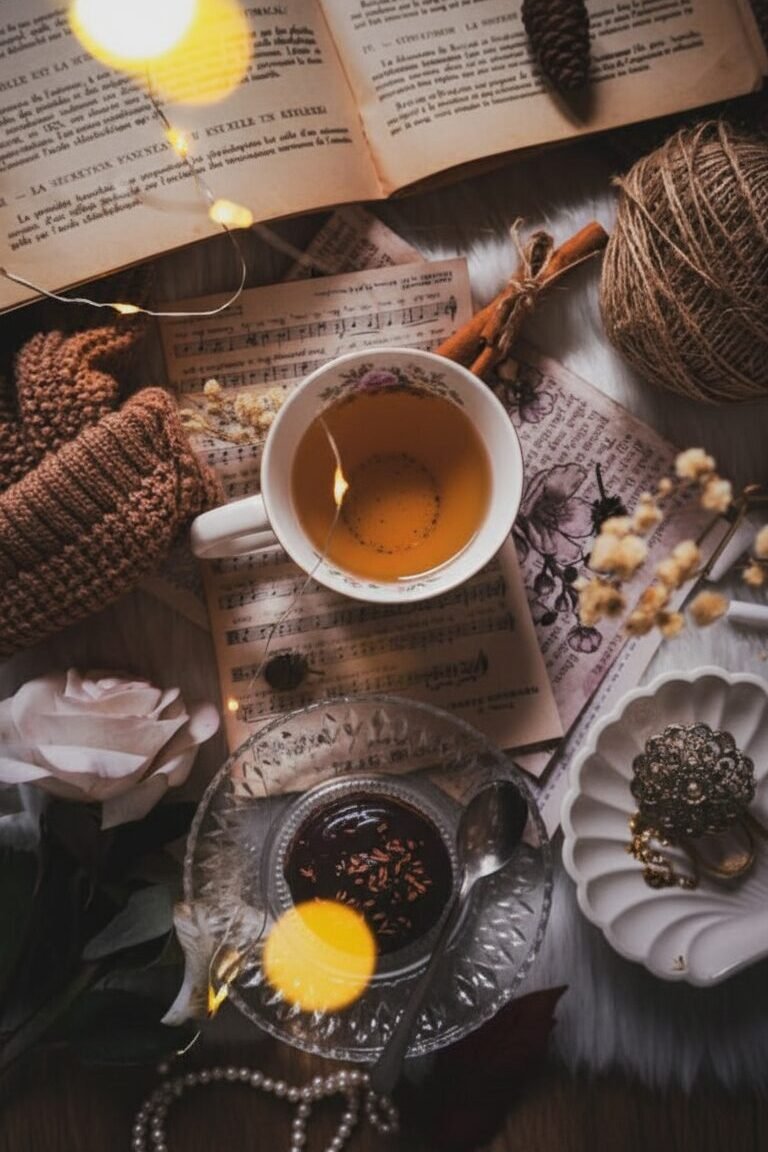
Chocolatiers like Mast Brothers and Valrhona offer single-origin bars with distinct notes such as cherry, tobacco, or even roasted nuts, all shaped by climate and soil. The taste can shift from earthy to fruity or floral depending on where the beans come from. For example, a bar made from Madagascan cacao often bursts with tart red fruit flavors that pair well with Darjeeling or Earl Grey tea.
Price points for single-origin options usually run higher than blends due to limited harvests and careful production methods.
Many pairing guides recommend these chocolates for focused tastings because they provide clear flavor profiles which help refine your palate over time. Tasting notes attached to each bar guide you in picking teas that enhance natural flavors; try bold black tea with Venezuelan dark chocolate or match green tea’s grassiness with creamy Ecuadorian white chocolate.
Regional Tea and Chocolate Matches
Single-origin chocolate spotlights the cocoa bean’s place of growth, but regional tea and chocolate matches go a step further.
They highlight combinations shaped by geography, local tradition, and climate. For example, Japan pairs matcha with white or milk chocolate for grassy notes balanced by creaminess. Ecuador often partners its floral Arriba Nacional cocoa with medium-roast oolongs grown in nearby Andean regions. These pairings reflect both history and environment; they often create flavors impossible to find in blends from different countries.
Regions such as Sri Lanka produce bright Ceylon black teas that shine alongside dark chocolates made from Trinidadian or Venezuelan beans.
Some specialty shops now offer pairing sets featuring teas and chocolates sourced from single locations like Assam or Madagascar, aiming to showcase natural harmony between local crops. Educational classes might trace the story behind each pairing set, emphasizing how regional terroir shapes everything from aroma profiles to mouthfeel in both tea leaves and cacao nibs.
How to Host a Tea and Chocolate Tasting

A tea and chocolate tasting creates a sensory journey that lets you explore new flavor pairings. Setting up your own tasting at home is easier than you might think.
Follow these practical steps to craft an experience that highlights distinct aromas, textures, and tastes.
Selecting Your Pairings
Choose high-quality loose-leaf tea and premium chocolate to elevate your chocolate and tea experience.
Match strength by pairing dark chocolate with strong teas like Pu-erh, Earl Grey, or a dark oolong so one flavor does not overpower the other. White chocolate provides a creamy canvas that works well with matcha or delicate green teas for balance. Milk chocolate finds harmony next to Milky Oolong, Spicy Chai, or classic black teas such as Darjeeling and English Breakfast.
Opt for curated tasting sets like the Socola x Dartealing Lounge Chocolate and Tea Pairing Set if you want expert guidance in making pairings.
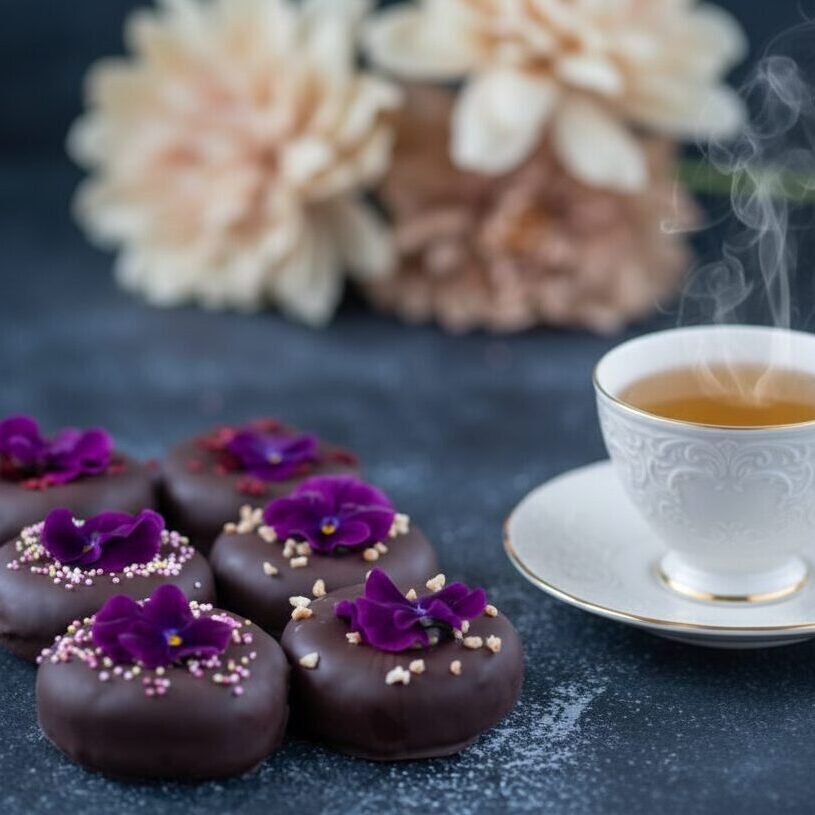
Experiment with different cocoa percentages since higher cocoa content can stand up to bolder brews, while lighter chocolates may pair best with subtle teas. Always prioritize personal taste preferences during selection; some individuals enjoy contrast while others prefer seamless blends of flavors on their palate.
Tasting Order and Palate Cleansing
After selecting your pairings, the tasting order helps set the stage for a balanced chocolate and tea experience.
Start with lighter teas, such as delicate white or green teas paired with creamy white or milk chocolate. These gentle flavors ease your palate in before moving on to darker oolongs and rich black teas meant for robust dark chocolate. Progress gradually from mild to bold combinations so that subtler notes shine through and stronger tastes do not overwhelm earlier samples.
Palate cleansing plays an important role throughout the session. Neutral foods like plain crackers or slices of green apple refresh your senses between tastings without leaving behind heavy residue.
Sip room-temperature water after each pairing to keep taste buds clear and receptive, allowing you to notice new flavors in every bite and sip. This routine ensures each tea-chocolate match stands out on its own, enhancing appreciation for the wide spectrum of pairing possibilities.
Creating a Tasting Experience
Select high-quality loose-leaf teas and premium chocolates to start your chocolate tea tasting.
Choose specific pairings such as white chocolate with green tea or dark chocolate with Earl Grey or pu-erh for clear examples of how flavors unite. Arrange small pieces of each chocolate alongside a cup of each chosen tea to highlight differences and similarities in flavor, aroma, and texture.
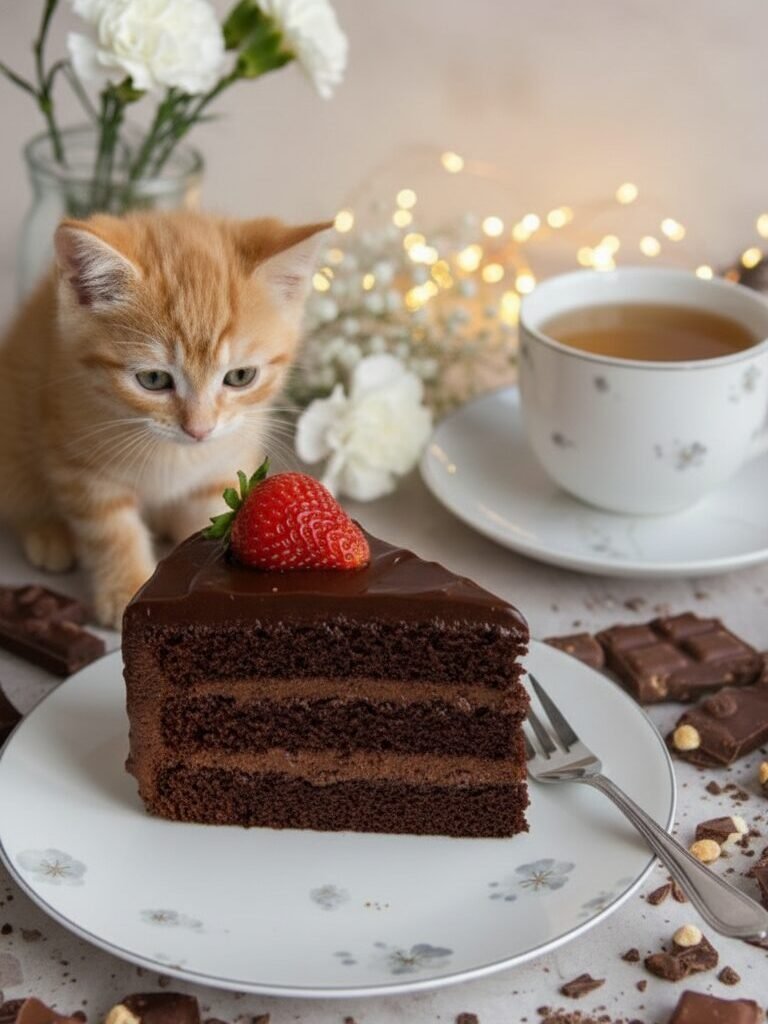
Encourage everyone at the table to notice the way tannins in black teas interact with cocoa butter or how citrusy notes from Earl Grey heighten dark chocolate richness. Use palate cleansers such as plain crackers or filtered water between sips and bites to reset taste buds.
The Socola x Dartealing Lounge Chocolate and Tea Pairing Set, featuring 12 artisan truffles matched with gourmet teas, offers a ready-made experience for both beginners and seasoned tasters. Engage in mindful tasting by taking time to savor both the tea’s profile and the chocolate’s lingering finish; this approach will maximize enjoyment during pairing sessions.
Conclusion: Finding Your Perfect Chocolate and Tea Match
Exploring chocolate and tea pairings creates a delightful taste adventure.
Every bite and sip brings out new flavors, aromas, and textures. Personal preference shapes the perfect match, making each pairing unique. Enjoy experimenting with different types of chocolate and loose-leaf teas for a truly refined experience.
FAQs
1. What makes chocolate and tea such a good pairing?
The magic lies in how their flavors complement each other. For instance, the astringent tannins found in a black tea can cut through the rich cocoa butter of dark chocolate, cleansing your palate for the next bite. This creates a balanced and more dynamic tasting experience than either would provide alone.
2. What is the most important principle for pairing?
The key principle is matching intensity levels. You want both the tea and the chocolate to be “heard” clearly. A delicate tea (like a Silver Needle white tea) will be overpowered by a bold dark chocolate, while a strong black tea will overwhelm a creamy white chocolate.
3. Which types of tea work best with different chocolates?
As a general rule, match intensity:
- Dark Chocolate (70%+): Pairs beautifully with bold, robust teas like Pu-erh, Dark Oolong, or a strong black tea like Earl Grey, whose bergamot notes cut the richness.
- Milk Chocolate: A wonderful match for Milky Oolong, Jasmine Green Tea, or the warm spices in a Masala Chai.
- White Chocolate: Try a light, grassy Japanese Sencha, a delicate White Tea, or a floral Chamomile to offset the sweetness.
4. What is the best way to host a tasting?
Start with your lightest pairings (e.g., white tea and white chocolate) and move to the boldest (e.g., black tea and dark chocolate). Most importantly, cleanse your palate between each pairing using plain crackers or sips of room-temperature water to reset your taste buds and ensure each pairing stands out.
5. Can I pair tea with chocolate desserts, not just bars?
Yes! The same principles apply. A rich chocolate cake, for example, pairs well with a full-bodied Assam or Earl Grey. A silky chocolate mousse can be brightened by a fruity tea (like Raspberry Nectar) or a floral jasmine green tea.
6. How should I prepare my tea for a pairing?
Brew your tea at its ideal temperature (such as around 175°F / 80°C for a green tea or 212°F / 100°C for a black tea). To experience the pure flavors as they interact, be sure to skip any milk or sugar.
References
- https://us.venchi.com/blog/chocolate-and-tea?srsltid=AfmBOooYZt2q5jcZPuGo9xwFRNnD7Z6xRO3EfT3Wy-AWX4wn7i6wnY0k
- https://worldwidechocolate.com/pairing-chocolate/chocolate-and-tea/?srsltid=AfmBOoqAfJAuSVQ9M4xGM8ErGQPWK6kzIjFevNTlru8f1AEz-XzT7lgz
- https://us.venchi.com/blog/chocolate-and-tea?srsltid=AfmBOorGXEM-povgv1x1Srd9CC2NVIqHcGVkSEYeIOFvAJRFCtNpJQCv
- https://www.researchgate.net/publication/263617622_An_investigation_on_the_appropriateness_of_chocolate_to_match_tea_and_coffee
- https://teaforte.com/blogs/tea-notes/an-expert-guide-to-pairing-tea-and-chocolate?srsltid=AfmBOoqdYBqJwLChaGnAhSlHtBnTRSlKZ8sO0b9HzxGVkIkSY_BJNSyp (2022-10-24)
- https://us.venchi.com/blog/chocolate-and-tea?srsltid=AfmBOorizZQ3oSIKG9rCtwbMpZ7CQXdqDZpNKzoEO9wEEoApMv9G_Iux
- https://orientalteabox.com/blogs/news/pairing-pu-erh-tea-with-food-best-combos-for-every-meal?srsltid=AfmBOop4eKsJY05ZBvhzbfZzlFE2G6n8aEFVemMtLPSK1B0DXXs-okNK
- https://us.venchi.com/blog/chocolate-and-tea?srsltid=AfmBOoq6l0ianCVsQyUL5pHOm0gmrPkSlXyk-z47TgsZAd9THSkyBoqk
- https://worldwidechocolate.com/pairing-chocolate/chocolate-and-tea/green-tea/?srsltid=AfmBOoo783t6vZ2Az2YMv7vqB8yOj6L7NlJTVOj6Gw7Hztsvl5YQBDDz
- https://teapro.co.uk/the-ultimate-guide-to-pairing-tea-and-chocolate-for-a-richer-experience/
- https://us.venchi.com/blog/chocolate-and-tea?srsltid=AfmBOoonVmtxsJdNaXp2MhVFyaoh3kY4Ju4ap6LDxuQvYp4EJh6xSXtt
- https://teaforte.com/blogs/tea-notes/an-expert-guide-to-pairing-tea-and-chocolate?srsltid=AfmBOoq_PhIRQ9_dQeoEtuReQ6qZB78Wd0PVprNU6IwQ84q9UCrVwdXF (2022-10-24)
- https://us.venchi.com/blog/chocolate-and-tea?srsltid=AfmBOoq5OcdQa2GRw7S5dCDsznGRoNGusM5AZTHDBr2bqOzthaxv4eDn
- https://www.ethelm.com/en-us/blog/chocolate-basics/chocolate-and-tea-pairing?srsltid=AfmBOooF_hPQoI-x2gsApHvV3OLjEAf9GcVthW8fmRcL5GMv5tcygCna
- https://us.venchi.com/blog/chocolate-and-tea?srsltid=AfmBOooSkpq_aaaEgPKbGpPNuGeZRhyRcKQ27BK7xgms-W1Ueq12S9VI
- https://www.cadburydessertscorner.com/articles/chocolate-and-tea-pairing-a-perfect-match-for-the-ultimate-confectionery-experience (2024-02-19)
- https://www.ahmadtea.com/chocolate-tea-pairings/ (2022-10-17)
- https://teaforte.com/blogs/tea-notes/an-expert-guide-to-pairing-tea-and-chocolate?srsltid=AfmBOopEgCfpqdXWNZ1SnRtAqfZ4RbxfvqWk-ThbMrnwNzI8w6c-1plr (2022-10-24)
- https://www.raakachocolate.com/pages/floral-tea-chocolate-pairing-class?srsltid=AfmBOooJg86VOG4bV3MFvD_PGxFuN2lh3AVw3fTvdJX75a4gpUNapi-0
- https://us.venchi.com/blog/chocolate-and-tea?srsltid=AfmBOor6l0SACw0fdxYnc1RP0j7udjpZ0cuS4-XticDbOAwPi9HFS9FT
- https://www.ethelm.com/en-us/blog/chocolate-basics/chocolate-and-tea-pairing?srsltid=AfmBOoqTFk5Zv5Eq0RFquVCwYIDz13rX_9ejcEHzs8ZxGE7tZ84VXuFJ
- https://www.republicoftea.com/blog/tea-culture/how-to-pair-tea-and-chocolate/tc-018/?srsltid=AfmBOoqwbmLGv6IsWpZrZInCCogSDgnfHUhJ9VipLWFl8QYofTTrH5y6 (2021-05-14)
- https://us.venchi.com/blog/chocolate-and-tea?srsltid=AfmBOooy4fcxbieqMBr9WcKAE9avLtY3AwbBQI2wLoxVjJvkP56jmeT6
- https://www.ethelm.com/en-us/blog/chocolate-basics/chocolate-and-tea-pairing?srsltid=AfmBOorwQHQWi_thB91uLjK-utuh0jfdIArZ571gmN0Eq-n5xheGiI-d
- https://teaforte.com/blogs/tea-notes/an-expert-guide-to-pairing-tea-and-chocolate?srsltid=AfmBOortz7a65oWeKSNmMLi-iFhP_6-4MnzKaV3xpvUPrtENxOrNg0Ow (2022-10-24)
- https://wandering-everywhere.com/pair-tea-chocolate/
- https://teaforte.com/blogs/tea-notes/an-expert-guide-to-pairing-tea-and-chocolate?srsltid=AfmBOooMWLjQXfmRKy_VKhePjWpCsHHYGMtR5QNn2yV05QL5JIHMkvlJ (2022-10-24)
- https://www.gourmetboutique.net/blogs/tasting-room/best-of-both-worlds-a-beginners-guide-to-tea-and-chocolate-pairings (2019-05-19)
- https://www.republicoftea.com/blog/tea-culture/how-to-pair-tea-and-chocolate/tc-018/?srsltid=AfmBOoqNuUH8XGtVphZkG01qnKhhBL9zeXRZkMMf7uISYpNwBrW0Jw02 (2021-05-14)




